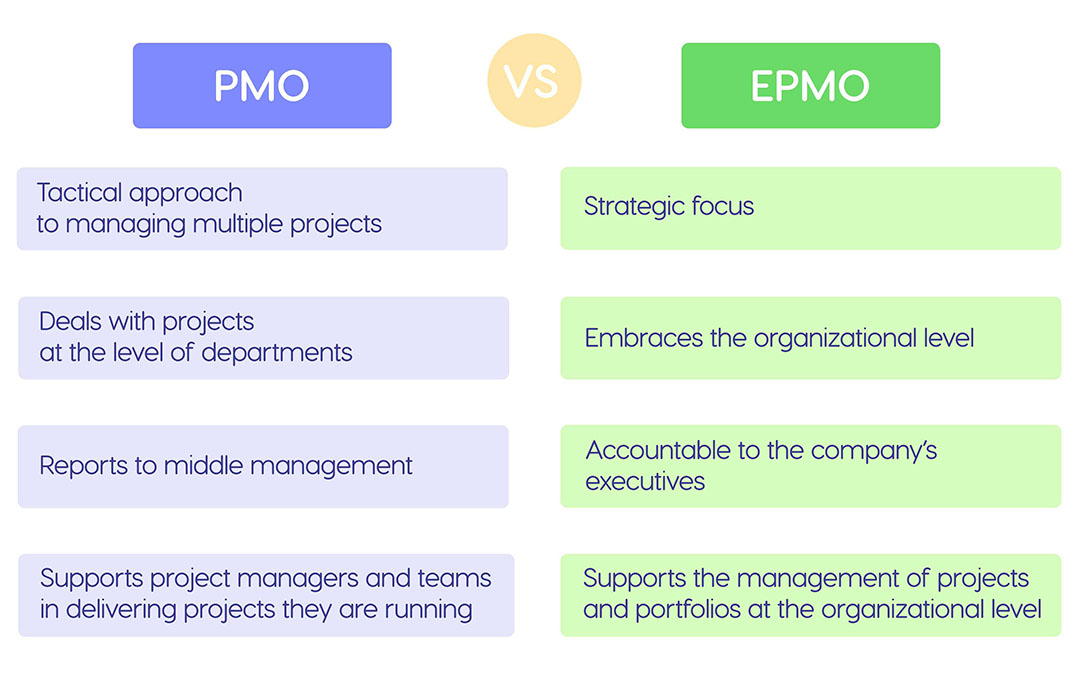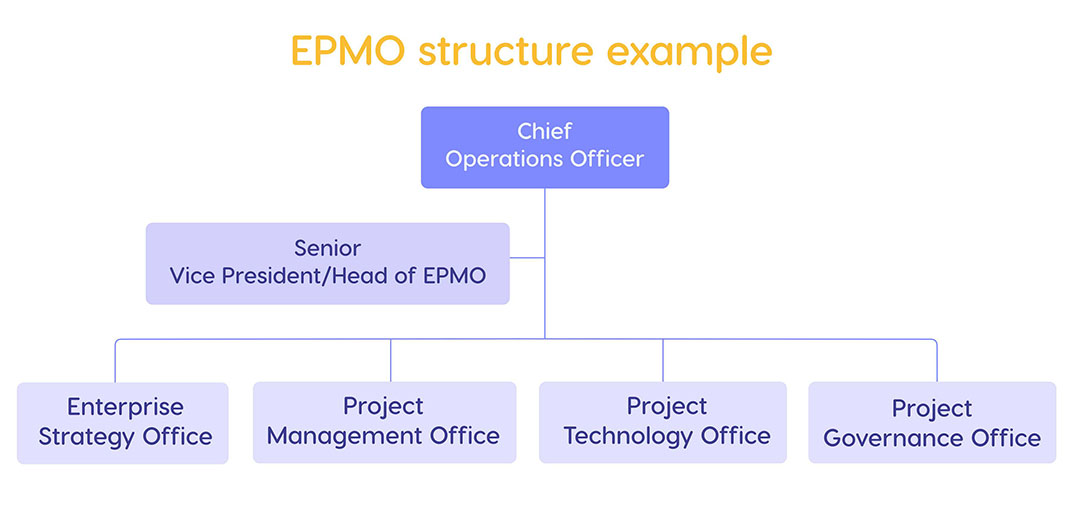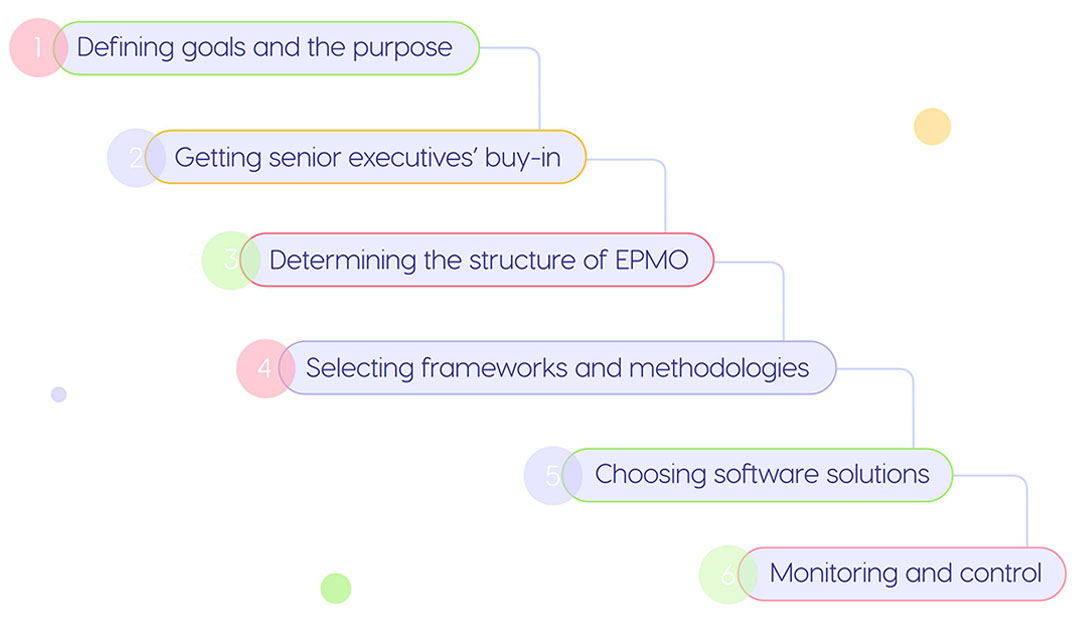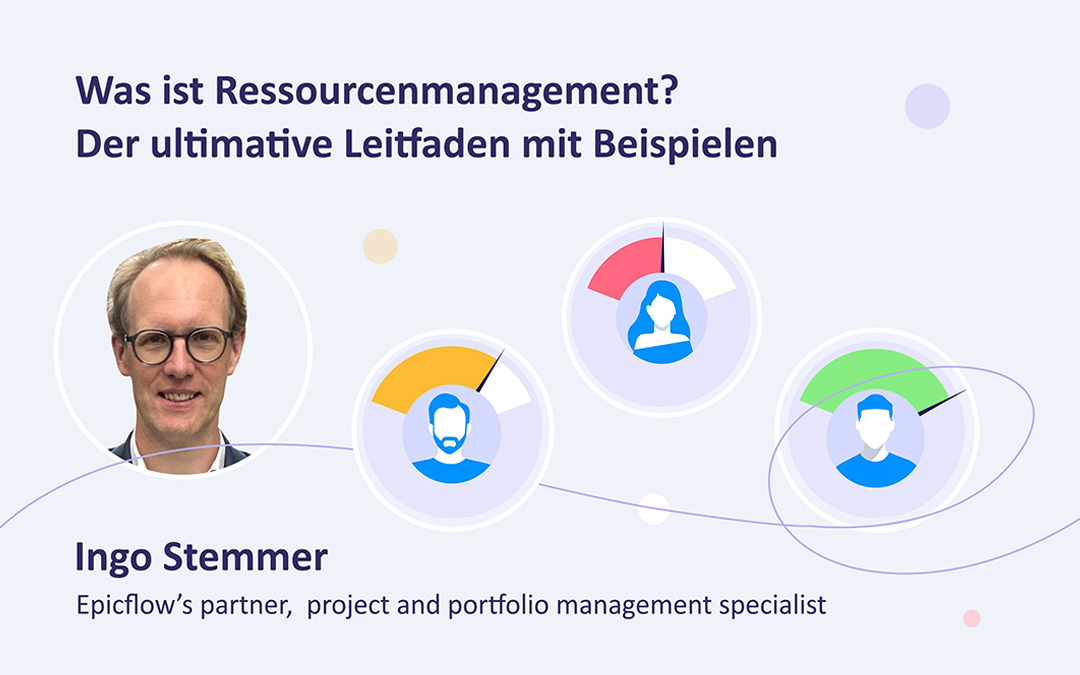
In a great number of modern companies, especially rapidly growing or large enterprises, uncoordinated project execution can hamper strategic progress. Addressing this challenge becomes possible with establishing specific departments that improve the project, program, and portfolio management processes at the strategic level. One of these organizational units is an enterprise project management office (EPMO).
What is EPMO responsible for? How does it differ from a traditional project management office? How to establish an EPMO? Read the article to find the answers to these and other questions.
What Is an EPMO?
Let’s start with determining the EPMO meaning. Enterprise project management office (EPMO) is an organizational department that helps companies oversee the execution of all their projects, programs, and portfolios. In other words, it’s a PMO but on the level of the entire organization. EPMO consists of professionals from different departments who are responsible for planning the portfolio of projects, project prioritization, overseeing strategic alignment, benefits realization, decision-making, etc. This organizational structure works with large-scale multiple complex projects as well as project portfolios across the organization.
You may think that an EPMO is something similar to a project management office, or a PMO. Yes and no. Let’s consider the detailed differences between these two organizational structures.
EPMO vs PMO: What’s the difference?
- The main difference between a PMO and EPMO is that a PMO takes a more tactical approach to managing multiple projects, while EPMO has a strategic focus.
- PMO deals with projects at the level of departments, while EPMO embraces the organizational level.
- PMO reports to middle management, and EPMO is accountable to the company’s executives.
- PMO supports project managers and teams in delivering projects they are running. EPMO supports the management of projects and portfolios at the organizational level.
In large organizations, these two departments may co-exist. They don’t replace each other, but complement each other’s activities. In some cases, EPMO may unite several PMOs.
Read more: Top 4 Challenges for a Project Management Office (PMO) and Ways to Address Them
Why EPMO Matters in Today’s Business Environment: Benefits of an EPMO
Establishing an enterprise PMO has the following benefits for an organization.
1. Providing strategic alignment and achieving organizational goals.
Enterprise portfolio management office makes sure that project management efforts across different departments are coordinated, they are aligned with strategic objectives and don’t contradict each other. In addition, it helps organizations achieve their goals: they work on and deliver those projects that are aligned with their business strategy and deliver value.
2. Establishing standards and processes.
Similar to PMOs, enterprise PMOs establish standardized processes and tools for managing projects and portfolios on the level of the entire organization. This simplifies the management of large and complex projects and improves coordination between different departments of a company.
3. Improving resource utilization.
EPMO deals with resource management on the enterprise level. In contrast to traditional PMOs that deal with resource allocation for individual projects, EPMO is involved in enterprise-wide resource and capacity planning, demand management, and helps with staffing highest-priority projects. As a result, companies can utilize resources more efficiently and be sure that there will be enough resources available to implement required initiatives.
Read more: Portfolio Management and Resource Allocation: What Do They Have in Common?
4. Facilitating effective decision-making.
EPMO contributes to more effective decision-making across the organization, and here’s why. First, it has enterprise-wide visibility into projects, programs, and portfolios run by a company. Also, they track benefits realization, strategy execution, resource utilization, ROI, and other parameters that help senior executives make informed decisions.
Finally, all these factors contribute to improving outcomes and increasing performance not only on the project level, but at the organizational level as well.
5. Cost optimization.
Thanks to enterprise-wide standardization, optimum resource utilization, ensuring strategic alignment, and effective decision-making, companies increase their operational efficiency, achieve their strategic goals more effectively, reduce unnecessary spending, and optimize their costs.
Does Your Organization Need an Enterprise PMO?
If you still have doubts whether your organization needs EPMO, let’s take a look at the signs indicating that it really does:
- Difficulties in ensuring strategic alignment of multiple concurrent projects run by a company.
- No centralized visibility into the project environment (including programs and portfolios) of the entire organization.
- Inconsistency between different departments and business units regarding program and portfolio management practices, which leads to reduced productivity.
- A lack of effective monitoring and control of projects, programs, and portfolios running in an organization.
- Inability to determine project demand based on the business strategy.
- Ineffective utilization of the available resources which results in bottlenecks and/or resource shortages.
- Inability to evaluate the value delivered by portfolios and programs.
- Poor visibility and control of financial performance and ROI.
- Intensive business growth or transformation resulting in increasing the number of projects and their complexity.
Any of these symptoms requires change and corrective action, but upon noticing several of them (which are sometimes interrelated), it can be a good idea to establish an enterprise PMO to streamline processes and get the desired results.
Typical Roles and Responsibilities of an EPMO
Typically, EPMO organizational structure is responsible for the following areas of PM activities across the organization. Remember that all of them are performed on the level of an enterprise.
- Strategic portfolio management: SPM deals with aligning portfolios with the corporate strategy, prioritizing projects based on their ROI, conducting scenario planning, assessing portfolio performance on the enterprise level, and providing comprehensive monitoring across all business units.
- Strategic planning: This includes resource and capacity planning, strategic alignment planning, enterprise-wide portfolio planning, and benefits realization planning.
- Enterprise-wide oversight of projects, programs, and portfolios: EPMOs monitor the portfolio management process from different sides to ensure that projects deliver the expected value and contribute to strategy execution.
- Resource management: Enterprise project portfolio management office deals with managing resources at the level of the entire enterprise, including resource planning, capacity planning, resource allocation, and utilization tracking.
- Budget management: EPMOs conduct cost analysis and management across the entire enterprise to ensure that budgets are allocated to the right projects and utilized efficiently.
- Risk management: EMPOs assess risks and determine the optimum ways to mitigate them (or take advantage if they’re positive) at the level of the organization.
- Decision-making: Though EMPOs aren’t final decision-makers, they provide strategic decision-making support regarding project prioritization, budget and resource allocation, conduct scenario planning, etc.
- Performance measurement: EPMOs control KPI to make sure that an organization is performing well and is on the right track to achieving expected value.
- Standardization: Setting standards and establishing key performance indicators (including communication standardization)
- Benefits realization: To enable effective benefits realization, EPMOs determine the expected benefits, help align projects with strategic objectives, track expected vs actual benefits, as well as conduct reviews and implement improvements.
These were the main functions performed by an enterprise-level PMOs. Now, let’s review the structure of these organizational units.
The Structure of Enterprise PMOs: Typical Positions
The structure of an EPMO team and roles within it vary across enterprises. Let’s consider some typical positions you may find in enterprise project management offices.
- Head of EPMO / EPMO director: This is a person responsible for the enterprise-wide portfolio execution and its strategic alignment. They define and implement mission and strategy, collaborate with C-suite executives, maintain stakeholder communication, approve methodologies, and lead EPMO teams.
- Chief project officer: It’s one of the senior executives who oversees project-related activities on the enterprise level. Their role is strategic.
- PMO analyst / PPM analyst: This role involves tracking portfolio performance, gathering data, creating reports, assessing risks and planning scenario as well as facilitating decision-making.
- Enterprise project manager / EPMO project manager: The role of enterprise PM involves overseeing multiple projects across different departments and ensuring that they will be delivered on time, within budget, and will deliver the expected project outcomes. EPM’s role is tactical.
- Project portfolio managers: They manage project portfolios of departments and business units, prioritize projects, allocate resources, assess portfolio performance, and ensure strategic alignment.
- Resource managers: Resource managers are responsible for planning resources across the enterprise, managing demand for different departments, supporting capacity planning, and resolving resource conflicts.
Here is another example of a different EPMO structure:
Now, it’s time to review the process of establishing an EPMO. Read the next section to learn the basic steps of this process.
How to Implement an Enterprise PMO in 6 Steps
Step 1. Defining goals and the purpose.
Before establishing an EPMO, you should determine the purpose – why does your organization need this organizational unit? What aspects of project/portfolio management process should be improved: strategic alignment, PM processes’ standardization, or anything else?
Step 2. Getting senior executives’ buy-in.
Getting executives’ support is critical for effective functioning of an EPMO. Without that, this department will be just a formality. This is why it’s important to provide the senior leadership with a clear idea of establishing an EPMO is a strategic necessity.
Step 3. Determining the structure of EPMO.
As we mentioned before, the structure of EPMOs isn’t standardized. So, you should determine the structure and governance that will match your organization’s needs in the best possible way.
Step 4. Selecting frameworks and methodologies.
Now, it’s time to determine how the EPMO will work – choose the methodologies, frameworks, templates, and KPIs. Different departments may use different approaches, as it can be more effective than using a single framework with no regard for departments’ specificity.
Step 5. Choosing software solutions.
Effective work of EPMO will be impossible without leveraging software tools. Adopting PPM or PMO tools that provide comprehensive visibility, resource management capabilities, real-time data analytics, and scenario planning features will be a good choice.
Step 6. Monitoring and control.
The final step is regular monitoring and control. Use previously established KPIs (e.g., strategic alignment, resource utilization, project success rate, etc.) to assess the effectiveness of enterprise PMO’s work.
To make sure that your enterprise PMO works effectively and delivers the expected results, following the above-mentioned implementation steps isn’t enough. Read the next section to discover the recommendations for the most effective EPMO implementation.
EPMO Best Practices: Tips for Effective Implementation
Tip 1. Start with a pilot EPMO.
If you’re working in a large enterprise, it can be a good idea to test EPMO framework and results you may achieve in one department or business unit, rather than in the entire enterprise. Why? Because this approach will allow you to determine what works well and what can be improved, and adjust your framework before scaling it to the entire organization.
Tip 2. Tailor EPMO operating model.
The governance model of an enterprise PMO includes the structure of this organizational unit, decision-making and prioritization principles, methodologies, and performance metrics. These parameters will depend on the size of an organization, the complexity of its operations, organizational culture, and other factors. These parameters should be taken into account when establishing the management model, while adopting one-size-fits-all solutions should be avoided.
Tip 3. Prioritize change management.
Establishing an EPMO is a change in an organization; it involves the transformation of the familiar ways of working on projects. This change can be met with resistance. This is why, it’s important to prepare for this resistance and work with employees and the management, explaining the importance of the organizational structure, how people’s work will change, and what the benefits of this change are.
Read more: Change Management Best Practices
Tip 4. Invest in the right software tools.
As we wrote earlier, leveraging the right software solutions is an essential step to achieving successful and effective work of an enterprise project management office. For example, Epicflow, a multi-project resource management software suitable for EPMOs, can provide them with the following capabilities:
- Comprehensive overview of all projects and portfolios running in a company;
- Resource management capabilities like resource allocation, demand forecasting, workload management, and performance analysis;
- Resource capacity planning software;
- Predictive capabilities for bottleneck detection and mitigation;
- Decision support with scenario analysis;
- Portfolio optimization features, and more.
Adopting such tools will give you the upper hand when it comes to effective functioning of an organizational PMO.
Final Words
Enterpise project management office has become a necessity for organizations that not only manage multiple concurrent projects, but also strive to ensure their alignment with a company’s business strategy. EPMO is an organizational unit that deals with enterprise-wide oversight of all projects, programs, and portfolios running in an organization. Compared to traditional PMO that deals with projects and portfolio of a single department, EPMO focuses on the entire organization. Companies implementing EPMOs have higher chances of achieving their business goals, optimizing resource utilization, and reducing costs.
Effective EPMO processes are impossible without the right software tools. Contact our experts to find out how Epicflow can optimize the work of your EPMO and facilitate achieving desired outcomes for your business organization.
Frequently Asked Questions
What does EPMO mean?
EPMO stands for enterprise project management office.
What is an EPMO in business?
EPMO stands for an enterprise project management office. This organizational structure is responsible for overseeing all projects, programs, and portfolios conducted by a business organization, ensuring their contribution to the business strategy and delivering expected value.
What is the difference between PMO and EPMO?
The main difference between these two organizational departments is in the scale. PMO operates on the level of a department, while EPMO deals with projects and portfolios of the entire organization. A project management office or even several of them can be included into an enterprise PMO.
What are the functions of EPMO?
EPMO is responsible for the following things: ensuring strategic alignment, enterprise-wide oversight of projects, programs, and portfolios, establishing standards, collaboration with C-suite executives and optimizing decision-making, improving resource utilization, managing costs, as well as increasing performance and ensuring that projects, programs, and portfolios deliver the expected value.
How to set up an EPMO?
To set up an EPMO, you need to define the strategic goals of this endeavor and determine the reasons why you need to do this. Then you should get executive leaders’ support for establishing this organizational structure. Also, it’s important to define standards, processes, and methodologies you’ll be following. Assign a team that will work in the EPMO. Conduct regular assessments and track performance.










